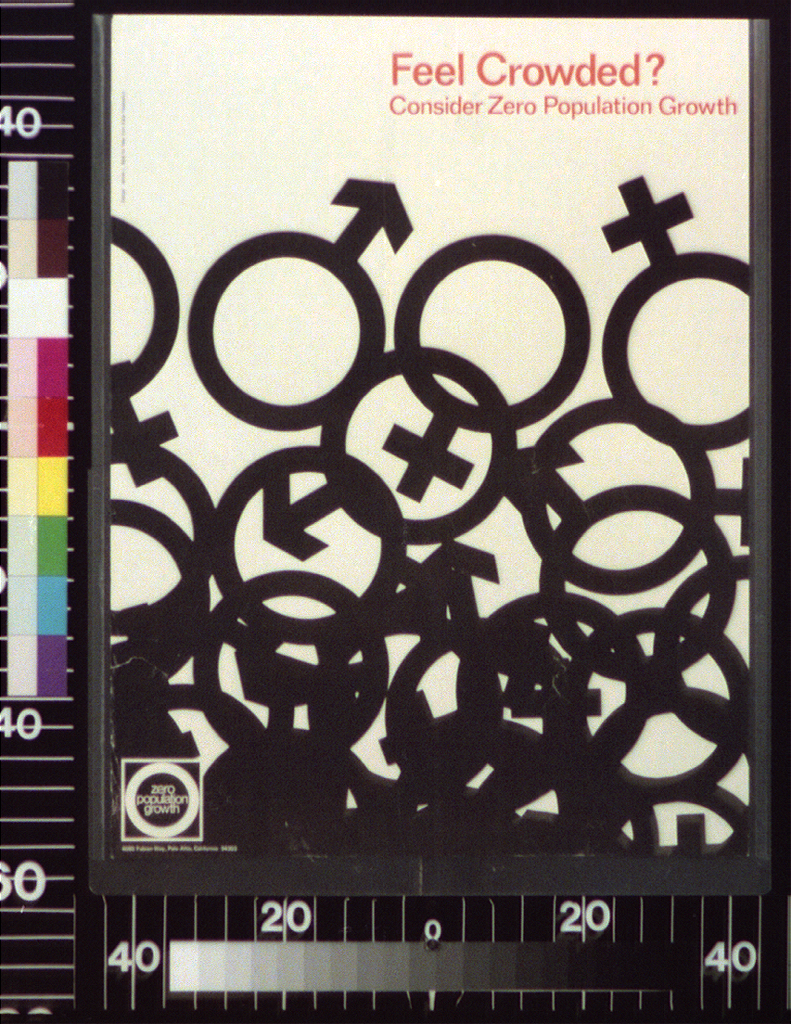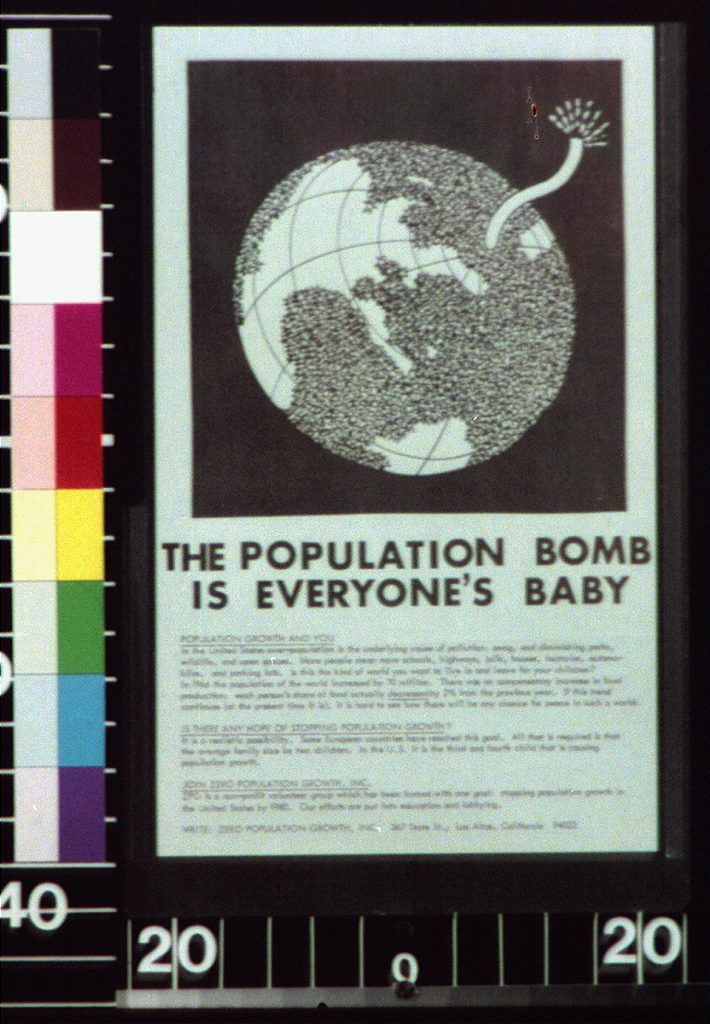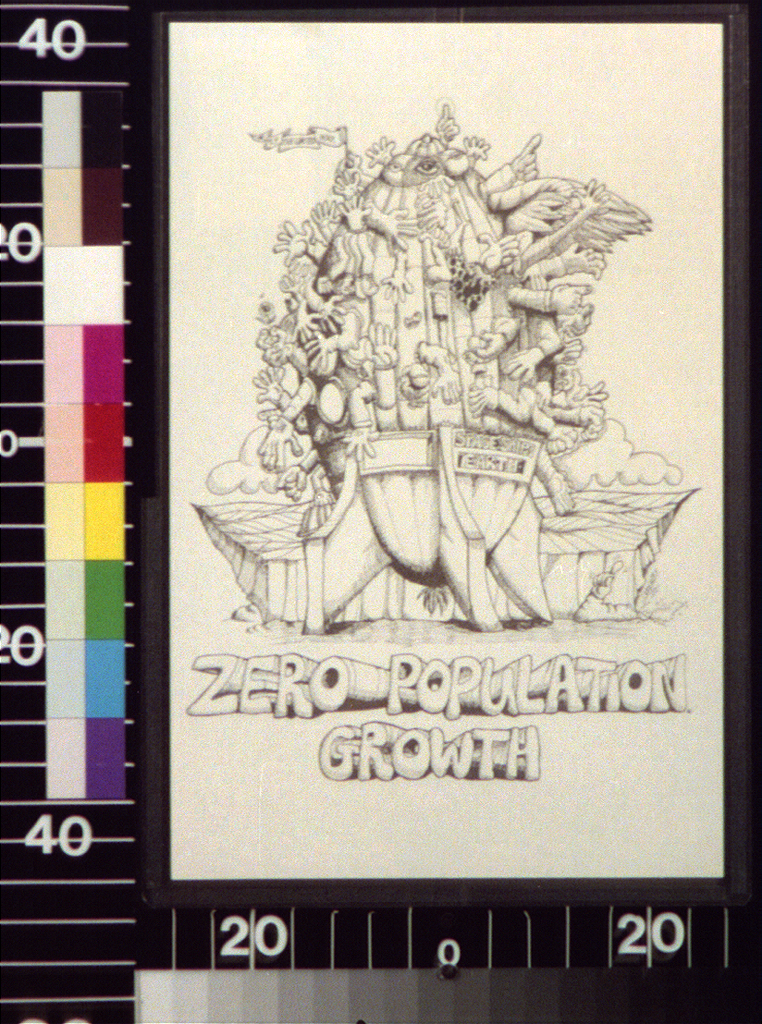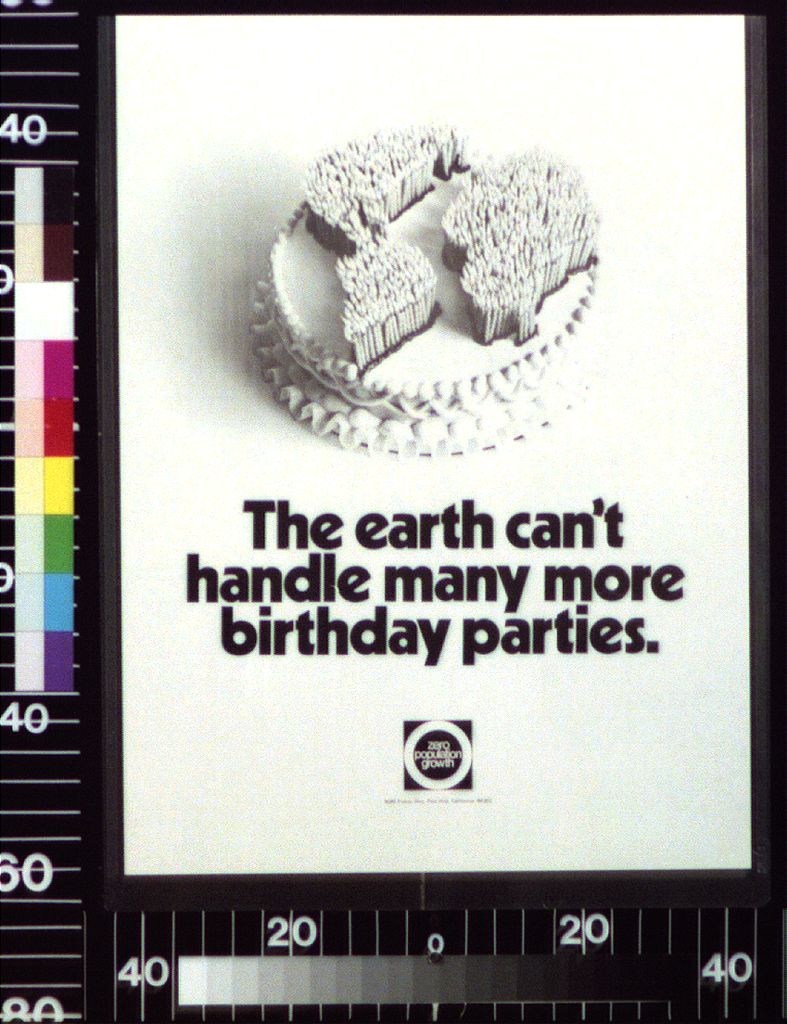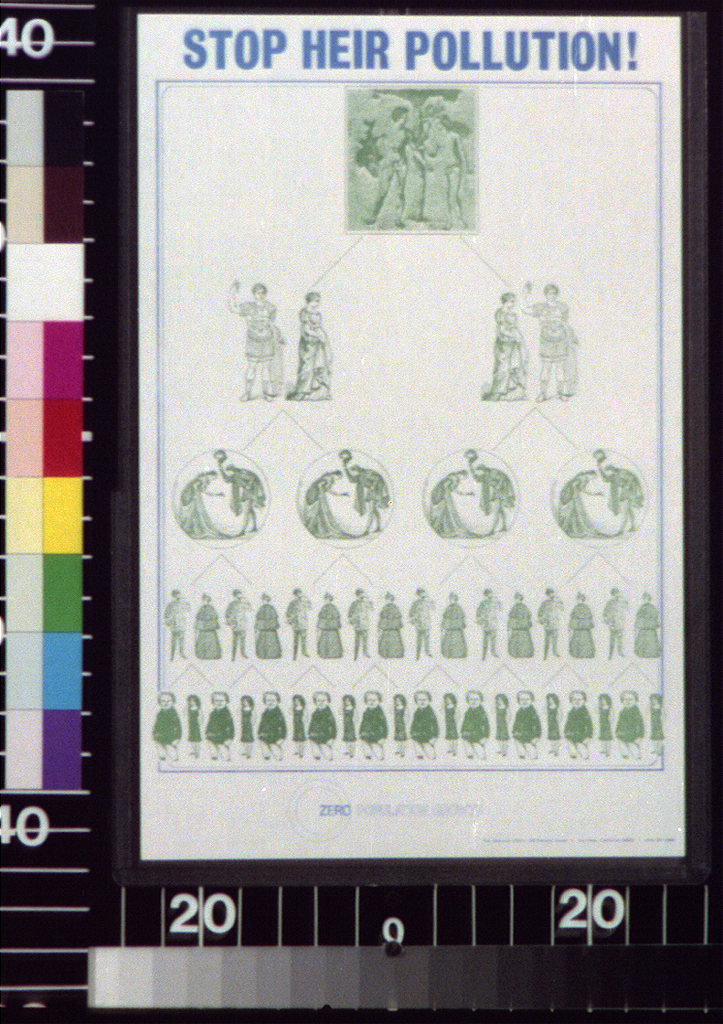The Population Bomb in the Rearview Mirror
Zero Population Growth Poster, 1968 [courtesy of the Library of Congress, Washington, D.C.]
Share:
“The battle to feed all of humanity is over. In the 1970s and 1980s hundreds of millions of people will starve to death in spite of any crash programs embarked upon now.”
— Paul Ehrlich, The Population Bomb
With these chilling words, butterfly biologist Paul Ehrlich opened his 1968 bestseller, The Population Bomb. His argument was simple: The world’s populace had grown more rapidly over the previous 50 years than it had ever done before. Food production could not keep pace (as clergyman Thomas Robert Malthus predicted almost 200 years earlier). Hunger facilitated the spread of communism, making nuclear war inevitable unless the United States and other wealthy nations facilitated a massive “die back” in countries Ehrlich deemed “beyond hope”—including India and Egypt—by cutting off food aid to them. According to Ehrlich, overpopulation threatened wealthy countries as well as poor ones. He blamed rising human numbers for the social upheaval that rocked the United States in the late 1960s, and for the environmental effects of new industrial manufacturing processes. The world’s population had grown dramatically over the previous 50 years, from about 1.8 billion in 1918 to about 3.5 billion in 1968. The rest of Ehrlich’s claims were largely speculative, but his scientific credentials gave them the aura of fact.
Although Ehrlich is popularly remembered for creating an environmentally focused population movement, very little of his book was original.1 By the time The Population Bomb hit bookshelves, the US Agency for International Development had already begun to pursue overseas population control, largely as a result of efforts by businessmen Hugh Everett Moore and William Henry Draper Jr.2 The title and much of the argument of Ehrlich’s book came directly from a 1954 pamphlet of the same name that was self-published by Moore.3 Beginning in 1961, under the auspices of the Committee to Check the Population Explosion, Moore and Draper placed full-page advertisements in national newspapers. Their ads urged Americans to pressure elected representatives to take action on overseas population control in order to halt the spread of communism and prevent nuclear war. In 1968, as part of an effort to bring “the population problem home,” Moore and Draper’s ads increasingly focused upon domestic concerns by presenting population growth as the primary cause of such issues as poverty, pollution, and urban strife.4
Written at the behest of the Sierra Club, Ehrlich’s Population Bomb combined Moore’s 1954 pamphlet, Moore and Draper’s advertisements, and other contemporary works of population alarmism into a bestselling paperback.5 Moore mailed Ehrlich’s book to his supporters with an explanation that it “expresses my own view of the frightening prospects of the world population out of control.”6 What was new about Ehrlich’s book was that it spread overpopulation anxiety to left-wing American youth, who then flooded into the campus chapters of Zero Population Growth (ZPG), a new organization started by Ehrlich and others to create grassroots political pressure for population control at home and abroad. By aligning population control with environmentalism and the sexual revolution, ZPG channeled student energy and anger away from critique of the Vietnam War and structural racism and toward pledging to limit the size of their own future families.
Zero Population Growth Poster, 1968 [courtesy of the Library of Congress, Washington, D.C.]
Zero Population Growth Poster, 1968 [courtesy of the Library of Congress, Washington, D.C.]
Zero Population Growth Poster, 1970 [courtesy of the Library of Congress, Washington, D.C.]
Moore and Draper were not the first to link population with the natural environment. They drew inspiration from two 1948 bestsellers, Road to Survival by ornithologist William Vogt and Our Plundered Planet by conservationist Fairfield Osborn, which in turn had been influenced by the work of eugenicist Guy Irving Burch.7 In 1929, Burch established the Population Reference Bureau with the aim of bringing the then-new social science of demography to popular attention, and to thereby garner support for immigration restriction and eugenic sterilization.8 Immediately after World War II, he published Human Breeding and Survival: Population Roads to Peace or War in an attempt to recuperate support for eugenic policies in a post-Holocaust world.9 Despite Burch’s frequent appeals to demography, however, his publications veered far from the findings of the demographers of his era, whom he assailed as “small-fry academics led by foreign born scientists.”10 Whereas the demographers of the 1930s charted falling birth rates in the United States, Burch instead forecast a looming “population explosion,”11 thus coining the term that Ehrlich would later popularize.
Zero Population Growth Poster, 1968 [courtesy of the Library of Congress, Washington, D.C.]
Zero Population Growth Poster, 1968 [courtesy of the Library of Congress, Washington, D.C.]
Zero Population Growth Poster, 1965 [courtesy of the Library of Congress, Washington, D.C.]
Demographers, for their part, dismissed the work of Burch, Osborn, and Vogt as unscientific and began to speak out against Ehrlich almost immediately after the publication of The Population Bomb.12 At the 1968 meeting of the Population Association of America (PAA, demography’s professional organization in the United States), Ansley Coale, a Princeton University demographer and then-president of PAA, devoted his presidential address to a critique of Ehrlich’s recommendation to limit births in the US. Coale complained that “it has become fashionable to explain almost every national failure or shortcoming by rapid population growth,” and that this trend obscured such causes as structural racism and the externalization of industrial pollution.13 Two years later, the PAA meeting featured an entire panel critiquing ZPG for diverting attention away from “other problems that should have priority, including the problems of the slums, racism, and the ‘urban crisis’ in general.”14 In January 1971, US Census Bureau demographer Conrad Taeuber announced that “economic and social factors are more important than population growth in threatening the quality of American life.”15
Even as demographers vociferously opposed Ehrlich’s efforts to pin domestic problems on population growth, they vigorously pursued population control overseas. American demographers worried that rapid population growth in decolonizing nations would prevent the economic development that economists believed necessary to steer those nonaligned countries away from communism.16 For some demographers, population control in the Global South was also a eugenic imperative to maintain global white supremacy.17 Despite such nefarious intentions, however, demographers typically pursued less extreme methods than ones proposed by Moore, Draper, Ehrlich, and ZPG. Instead, they emphasized nominal voluntary family planning and eschewed overt limits on childbearing.18 In the face of this consensus between natural and social scientists around the need to slow population growth in Africa, Asia, and Latin America, critique of overseas population control would come from intellectuals in the Global South, who effectively derailed US efforts to control the world’s population at UN conferences in 1972 and 1974.19
By that time, the world had passed its peak rate of population growth (about 2.1% annually), and the US birth rate had fallen below replacement (approximately 2.1 children, on average, per woman).20 As membership in ZPG began to decline, the organization increasingly turned its efforts toward anti-immigration activism, thus giving rise to what we now know as eco-fascism.21 In the 1970s, neoliberal economists began to suggest that population growth could actually be good for the environment, as it would stimulate the replacement of scarce (and therefore expensive) resources with more abundant (and therefore cheaper) ones. In 1980, Ehrlich accepted a bet proposed by economist Julian Simon over changes in the price of metals during the next decade. Ehrlich lost the bet and quietly paid Simon in 1990.22 Yet Simon’s win did not indicate the end of our environmental woes, which have only worsened since Ehrlich’s time. More recently, natural scientists have coined the term Anthropocene to describe our current geological epoch as one in which human activity is the primary driver of biogeochemical change.23 Whereas human activities have created the climate crisis we now face, the term Anthropocene risks conflating human activities with human numbers. This confusion is leading to a revival of the alarmism popularized by Ehrlich’s Population Bomb. New calls for population control are once again diverting our attention from corporate malfeasance and regulatory solutions by individualizing a structural problem.24
Emily Klancher Merchant is an associate professor of science and technology studies at UC Davis, where she teaches courses on gender and science, health and medical technologies, and data analysis and visualization. She is the author of Building the Population Bomb (Oxford University Press, 2021), which received awards from the Organization of American Historians and the American Sociological Association. She is currently writing a book on the history of behavior genetics and sociogenomics in the US over the past 100 years.
References
| ↑1 | For the longer history of environmental Malthusianism, see Thomas Robertson, The Malthusian Moment: Global Population Growth and the Birth of American Environmentalism (New Brunswick, NJ: Rutgers University Press, 2012). For the longer history of population science, see Emily Klancher Merchant, Building the Population Bomb (New York: Oxford University Press, 2021). |
|---|---|
| ↑2 | Reimert Ravenholt, “Interview with Rebecca Sharpless for the Population and Reproductive Health Oral History Project,” July 18–20, 2022, Sophia Smith Collection, Smith College. |
| ↑3 | Hugh Everett Moore, The Population Bomb, 1954, folder 17, box 16, Hugh Moore Fund Collection, Seeley E. Mudd Manuscript Library, Princeton University (hereafter HMFC). |
| ↑4 | “Manhattan Ad Schedule,” February 2, 1968, folder 8, box 17, HMFC; Hugh Everett Moore to Emerson Foote, Harry Hicks, and J. Drew Catlin, January 5, 1968, folder 8, box 17, HMFC. |
| ↑5 | Other influences on Ehrlich included William Paddock and Paul Paddock, Famine 1975! America’s Decision: Who will Survive (Boston: Little, Brown, 1967) and Robert Rienow and Leona Train Rienow, Moment in the Sun: A Report on the Deteriorating Quality of the American Environment(New York: Dial Press, 1967). |
| ↑6 | Hugh Everett Moore, “Form Letter,” January 10, 1969, folder 5, box 17, HMFC. |
| ↑7 | Fairfield Osborn, Our Plundered Planet (Boston: Little, Brown, 1948); William Vogt, Road to Survival (New York: William Sloane Associates, 1948). All of the population information in these books comes from Population Reference Bureau publications. |
| ↑8 | Guy Irving Burch to Hugh Everett Moore, October 16, 1948, folder 9, box 19, HMFC. |
| ↑9 | Guy Irving Burch and Elmer Pendell, Human Breeding and Survival: Population Roads to Peace or War (New York: Penguin, 1947). |
| ↑10 | Guy Irving Burch to Hugh Everett Moore, June 10, 1949, folder 10, box 19, HMFC. |
| ↑11 | Guy Irving Burch, “Headed for the Last Census? I” and “Headed for the Last Census? II. The Differential Birthrate,” Journal of Heredity 28 (1937): 241–254. |
| ↑12 | George F. Mair, ed., Studies in Population: Proceedings of the Annual meeting of the Population Association of America at Princeton, New Jersey, May 1949 (Princeton, NJ: Princeton University Press, 1949). |
| ↑13 | Ansley J. Coale, “Should the United States Start a Campaign for Fewer Births?” Population Index 34 (1968): 467. |
| ↑14 | Philip M. Hauser, Judith Blake, and Paul Demeny, “Discussion,” Population Index 36 (1970): 452–465. |
| ↑15 | “Clipping from Newsweek,” January 25, 1971, folder 7, box 16, series 1, Paul R. Ehrlich Papers, Stanford University Library (hereafter PREP). |
| ↑16 | Ansley J. Coale and Edgar M. Hoover, Population Growth and Economic Development in Low-Income Countries: A Case Study of India’s Prospects (Princeton: Princeton University Press, 1958). |
| ↑17 | Dudley Kirk, Oral History with Jean van der Tak, in Demographic Destinies: Interviews with Presidents and Secretary-Treasurers of the Population Association of America, vol. 1 Presidents, no. 1 1947–1960, ed. Jean van der Tak (Washington, D.C.: Population Association of America, 2005), 115–138. |
| ↑18 | Bernard Berelson, “Beyond Family Planning,” Science 163, no. 3867 (February 7, 1969): 533–543. |
| ↑19 | Joe Alex Morris Jr., “World Population Issue Surfaces at Conference: Third World Nations Indicate that They Will Oppose Family Planning as Conspiracy,” Los Angeles Times, June 10, 1972; Jason L. Finkle and Barbara B. Crane, “The Politics of Bucharest: Population, Development, and the New International Economic Order,” Population and Development Review 1, no. 1 (1975): 87–114. |
| ↑20 | Jack Rosenthal, “Nation’s Births Show Drop Below Zero-Growth Level,” New York Times, December 5, 1972. |
| ↑21 | Zero Population Growth, “A Recommended Population Policy for the United States,” 1976, folder 6, box 3, series 4, PREP. |
| ↑22 | Paul Sabin, The Bet: Paul Ehrlich, Julian Simon, and Our Gamble over Earth’s Future (New Haven, CT: Yale University Press, 2013). |
| ↑23 | Paul Crutzen, “Geology of Mankind,” Nature 415 (2002): 23. |
| ↑24 | Sarah Conly, One Child: Do We Have a Right to More? (New York: Oxford University Press, 2018); Travis Rieder, Toward a Small Family Ethic: How Overpopulation and Climate Change Are Affecting the Morality of Procreation (Cham, Switzerland; Springer, 2016). |
